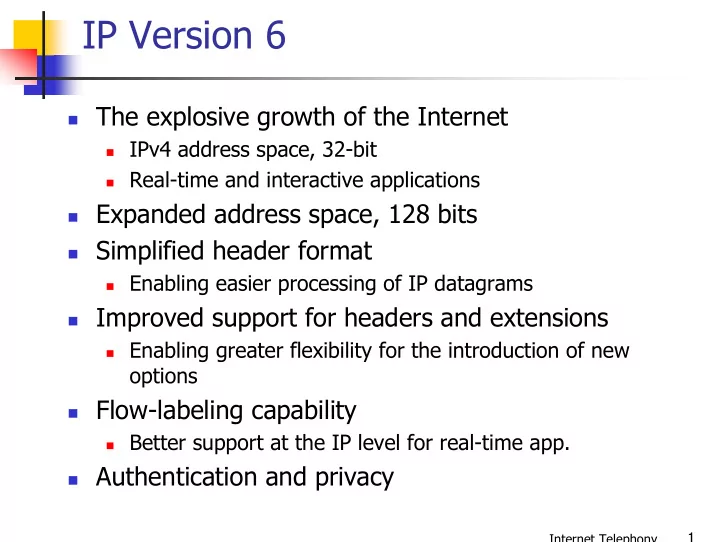

IP Version 6 � The explosive growth of the Internet � IPv4 address space, 32-bit � Real-time and interactive applications � Expanded address space, 128 bits � Simplified header format � Enabling easier processing of IP datagrams � Improved support for headers and extensions � Enabling greater flexibility for the introduction of new options � Flow-labeling capability � Better support at the IP level for real-time app. � Authentication and privacy 1 Internet Telephony
IPv6 Header [1/3] 2 Internet Telephony
IPv6 Header [2/3] � Version � 6 � Traffic Class, 8-bit � For the quality of service � Flow Label, 20-bit � Label sequences of packets that belong to a single flow � A flow := source address, destination address, flow label 3 Internet Telephony
IPv6 Header [3/3] � Payload Length, 16-bit unsigned integer � The length of payload in octets � Header extensions are part of the payload � Next Header, 8-bit � The next higher-layer protocol � Same as the IPv4 � The existence of IPv6 header extensions � Hop Limit, 8-bit unsigned integer � The TTL field of the IPv4 header � Source and Destination Addresses, 128-bit 4 Internet Telephony
IPv6 addresses � XXXX:XXXX:XXXX:XXXX:XXXX:XXXX:XXXX:XXXX � X is a hexadecimal character � E.g., 1511:1:0:0:0:FA22:45:11 � The symbol “ :: ” can be used to represent a number of contiguous fields with zero values. � = 1511:1::FA22:45:11 � 0:0:0:0:AA11:50:22:F77 = ::AA11:50:22:F77 � “ :: ” can appears only once 5 Internet Telephony
IPv6 special addresses � The all-zeros address, :: � An unspecified address; a node does not yet know its address � The loopback address, ::1 � On a virtual internal interface � IPv6 address with embedded IPv4 address (type 1) � 96-bit zeros + 32-bit IPv4 address � ::140.113.17.5 � Used by IPv6 hosts and routers that tunnel IPv6 packets through an IPv4 infrastructure � IPv6 address with embedded IPv4 address (type 2) � 80-bit zeros + FFFF + 32-bit IPv4 address � 0:0:0:0:0:FFFF:140.113.17.5 � ::FFFF:140.113.17.5 � Applied to nodes that do not support IPv6 6 Internet Telephony
IPv6 Header Extensions � To be placed between the fixed header and the actual data payload � Next Header � The type of payload carried in the IP datagram � The type of header extension � Each extension has its own next header field. 7 Internet Telephony
Header extension � Use the next header field 8 Internet Telephony
Hop-by-hop Extension [1/3] � It is only one exception. � Examined and processed by every intermediate node � If present, the hop-by-hop extension must immediately follow the IP header � Of variable length � Next header � Length � in units of eight octets � Options � TLV (Type-Length-Value) format � Type: 8-bit � Length: 8-bit (in units of octets) � Value: variable length � Type [0:2] are of special significance 9 Internet Telephony
Hop-by-hop Extension [2/3] � Hop-by-hop header extension 10 Internet Telephony
Hop-by-hop Extension [3/3] � Option Type: the first two bits (how the node react if it does not understand the option) � 00: skip this option and continue processing the header � 01: discard the packet � 10: discard the packet and send an ICMP Parameter Problem, Code 2 message to the originator of the packet � 11: do above only if the destination address in the IP header is not a multicast address � Option Type: the third bit � 1, the option data can be changed � 0, cannot 11 Internet Telephony
� Destination options extension � Has the same format as the hop-by-hop extension � Only the destination node examine the extension. � Header type = 60 � Routing Extension � A routing type field to enable various routing options � Only routing type 0 is defined for now � Specify the nodes that should be visited 12 Internet Telephony
Routing Extension [1/2] 13 Internet Telephony
Routing Extension [2/2] � Routing type � Segments Left � The number of nodes that still need to be visited � A list of IP addresses needs to be visited � Is this type of header analyzed by intermediate node? � Yes or no � A->Z, 3, (B,C,D) � A->B, 3, (C,D,Z) � A->C, 2, (B,D,Z) by B � A->D, 1, (B,C,Z) by C � A->Z, 0, (B,C,D) by D 14 Internet Telephony
Interoperation IPv4 and IPv6 � IPv4 and IPv6 will coexist for a long time � IPv4 nodes � IPv6 nodes � IPv6 nodes � IPv6 nodes via IPv4 networks � IPv4 nodes � IPv4 nodes via IPv6 networks � IPv4-compatible nodes with IPv4-compatible addresses at the boundaries of IPv6 networks � IPv6 in IPv4 packets 15 Internet Telephony
Recommend
More recommend